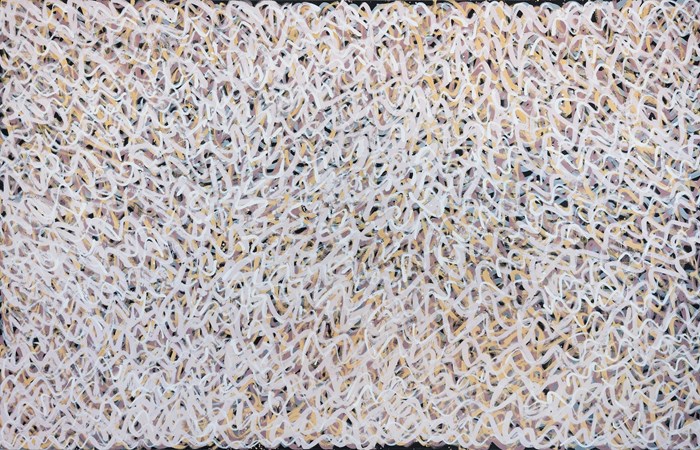KITTEY MALARVIE: MILKWATER AND LUGA NEWS

Launching in March 2017, JGM Gallery is a new space in London dedicated to exhibiting and promoting contemporary Australian Aboriginal artFor its inaugural exhibition, the Gallery will present the first UK exhibition by Indigenous Australian painter, Kittey Malarvie – Kittey Malarvie: Milkwater and Luga runs from 17th March to 22rd April Malarvie’s richly layered paintings refer to the artist’s deep-seated connection to the landscape and sites of her childhood, as well as a reflection on questions pertaining to identity, memory and displacement.
For its inaugural show, JGM Gallery is proud to present the first UK exhibition by Australian Aboriginal artist, Kittey Malarvie (b.1939). Founded by Jennifer Guerrini-Maraldi, the new space will deliver a rich programme of exhibitions and events devoted to contemporary Australian Aboriginal art. Kittey Malarvie: Milkwater and Luga is the first in a series of exhibitions that aims to demonstrate the rich potency, symbolism and heritage of Aboriginal art and culture on an international arena.
Malarvies subtle, abstract paintings reflect the artists deep-rooted connection to nature and her work consists of layers of cultural meaning, childhood memories and recollections of family histories. The two series presented at JGM Gallery, Milkwater and Luga, depict the remarkable desert landscape around Sturt Creek, Australia, where the artist spent her childhood, an area that sits between the Great Sandy Desert and Kununurra, Western Australia. At the heart of Malarvies practice is an enduring connection to her traditional country and childhood memories as a way of reconnecting with a time before the disruptions to family and cultural traditions that have occurred during her lifetime and throughout Aboriginal history. Painting in a
palette of soft earth ochres, including natural pale pinks, black, greys and milky white, Malarvie translates the language of place into energetic gestures of abstraction. Layers of circle motifs in the Luga paintings represent a land that is flooded and dry by turns, leaving behind the patterned ground of luga the cracked mud across the parched black soil plains of Sturt Creek. The white circles specifically refer to the salt crystals found in the mud and that are believed to have healing powers. Malarvies recent Milkwater series, by contrast, is a meditation on the multifaceted play of wind and light on this same area of land in times of flooding, when the water takes on the eerily beautiful colour of milk.
Like many Aboriginal artists, Malarvie works within the iconographic traditions of the desert, deeply in tune with the natural environment and ecology. Herself a healer, Malarvies paintings seem to capture not just the elements but also a certain energetic presence within them. Having had her first solo exhibition at the age of 68, these series together also form a visual biography. In her own words, When I paint, I remember my childhood... when we were all together..., an homage to her late sister.
For the Aboriginal community today, painting inasmuch as it is a form of traditional mark making with a centuries old existence retains its communicative function. Dating back 60,000 years, Indigenous Australian culture has consistently used painting for demarcating space, place and body: from paintings of detailed maps in the red sandy soil to ceremonial body painting and decorating traditional objects. In more recent decades, Aboriginal art can be viewed as a re-assertion of identity set within the context of a long and difficult period of colonial dominance and displacement. According to Jennifer Guerrini-Maraldi, Director of JGM Gallery, Aboriginal artists are custodians of a different aspect of the earth they have intellectual copyright for a pattern which has symbolic meaning... and a spirituality that is uplifting.
A fully illustrated catalogue of the exhibition will be published with a newly commissioned text by award-winning poet and journalist Olivia Cole.
About JGM Gallery
Based in Battersea, JGM Gallery is Londons only dedicated space for contemporary Indigenous Australian art. JGM Gallery aims to establish a greater awareness of Aboriginal art in the UK and internationally. The Gallery works only with registered Aboriginal owned art centres across the whole of Australia, ensuring that works are ethically sourced and that local communities directly benefit.
Located in the heart of Battersea, JGM Gallery is set to become one of the cultural markers of the neighbourhood, which is already home to the Royal College of Art, Battersea Arts Centre and Battersea Power Station.
About Kittey Malarvie (b. 1939)
Kittey Malarvie was born at the Brockman gold mine near Halls Creek, Western Australia. Malarvie travelled with her family to the East Kimberley township of Kununurra in the early 1970s where she first learned boab carving and artefact making with her parents. She turned to painting in 2006, having first assisted the late Rover Thomas (c. 1926-1998) and Billy Thomas (b. c. 1920). She works through one of the earliest Aboriginal art centres in the region. Her works are included in international collections at the Nevada Museum of Art, the National Gallery of Australia Collection and the Government of Western Australia.
Contacts For further press information please contact Anya Harrison at Kallaway PR anya.harrison@kallaway.com | jgmgallery@kallaway.com +44 (0)20 7221 7883 JGM Gallery 24 Howie Street SW11 4AY info@jgmgallery.com +44 (0)7860 325 326 Opening Times Tues-Fri 11am-6pm Sat 11am-5pm www.jgmgallery.com

 Popular
Popular Recent
Recent Comments
Comments

















